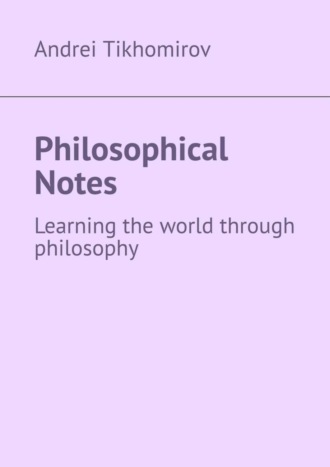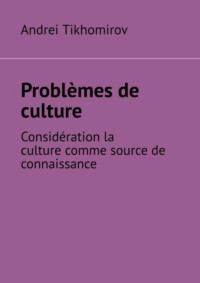
Полная версия
Philosophical Notes. Learning the world through philosophy
The practical function suggests that culture serves the purpose of transforming nature through knowledge and tools. This function symbolizes the isolation of man from the rest of the animal world and his elevation above him as an active and creative being.
The axiological function means that culture is a «receptacle» of values, i.e. positive products of a person’s spiritual activity – ideas, ideals, images, etc. For centuries, society has accumulated universal values expressed in the moral ideas of goodness, justice, conscience and others.
Finally, the socializing function indicates the role of culture in the formation of the human in man – high needs and noble deeds. Without familiarization with culture (science and art, the traditions of society), there cannot be and cannot be a man brought up. A cultural person, from the point of view of philosophy, is a person who has mastered all the wealth of human culture.
Very often in philosophy, along with culture, the concept of civilization is also used. Not infrequently, these concepts are applied in the same sense. But, although these concepts are somewhat close, such an application is incorrect. Civilization is a definite major epoch in the history of mankind, a step in the development of man as an agent and creator. Culture is the content of a particular historical era, expressed in the totality of spiritual and material values. Each civilization has its own specific culture.
In the cultural aspect, it is also necessary to say about the interaction of philosophy and religion. Today, the issues of religion, its place in modern society, its role in it, its amazing «vitality» are attracting universal attention and make us take a fresh look at our history. Culture and religion are historically determined social phenomena. We can say that religion has some very deep roots and is not a «delusion» with which science can easily cope. Religion is closely related to the extra-logical form of consciousness; it is involved in the formation of the extra-logical knowledge of man. However, religion is not at all limited to the knowledge of the world; the range of its tasks is much wider. The behavior of a person in the world is based on knowledge about him. This knowledge is formed, as it were, in two interconnected spheres – one where logic has a decisive word, and the other where feelings, compassion, love for one’s neighbor dominate. In harmoniously developed people, both sources of knowledge – both logical and non-logical – are in a certain equilibrium and determine behavior. Humanity needs a holistic worldview, the foundation of which lies both the scientific picture of the world and its extra-scientific perception.
Religion, like philosophy, is a form of social consciousness. Religious consciousness is a «compensator» of a person’s social weakness. It is characterized by belief in the supernatural and thinking by dogmas. The main object of reflection in religious consciousness is God as allegedly the Creator and Savior of the world and man. Reflection of the world in this form of social consciousness is carried out in the form of fantasies and beliefs, feelings and motivations, cult actions.
Philosophical consciousness is accessible, as a rule, only to the most educated part of society. It includes not only accurate knowledge, but also the wisdom of a person as a generalization of his life experience. Unlike the exact sciences, philosophy is always inherent in a personal attitude to the phenomena of social life. None of the sciences explores the most complex worldview questions about the meaning of a person’s life, about his death and immortality, about his calling in society. For philosophy, all this is one of its most important tasks.
Briefly speaking, philosophy develops a person’s ability for theoretical thinking and the formation of one’s own worldview. In this sense, as noted by G. Hegel, «there is no worse means for obtaining daily bread than philosophy.» It is primarily the art of thinking, designed to help a person gain wisdom, or «good mind» as an important intellectual characteristic. True wisdom is, in the words of Heraclitus, «to speak the truth and, listening to the voice of nature, to act according to it.» A wise person is one who not only thinks correctly, but also acts correctly.
So, philosophy is a very ancient and multidimensional phenomenon of the spiritual culture of mankind. Its specificity and a special role in the life of society and the individual (the development of the ability to theoretical thinking and the formation of a worldview) requires a serious and thoughtful attitude to it. Philosophy is a synthesis of Truth, Good and Beauty, the core of the spiritual culture of human society.
Philosophical ideas of the East
Philosophical ideas in ancient India began to take shape around the second millennium BC. Humanity does not know earlier examples. In our time, they became famous thanks to the ancient Indian literary monuments under the general name «Vedas», literally meaning knowledge, knowledge. The Vedas are a kind of hymns, prayers, chants, spells, etc. They are written approximately in the second millennium BC. e. in Sanskrit.
For the first time, the Vedas make an attempt to approach the philosophical interpretation of the human environment. Although they contain a semi-superstitious, semi-mythical, semi-religious explanation of the world around a person, nevertheless they are considered as philosophical, or rather pre-philosophical, pre-philosophical sources. Actually, the first literary works in which attempts are made to philosophize, that is, to interpret the world around a person, could not be different in content.
The philosophical works corresponding to our ideas about the nature of the statement of problems, and the form of presentation of the material and their solutions, are the Upanishads, which literally means sitting at the feet of the teacher and receiving instructions. They appeared approximately in the 9th – 6th centuries BC and in form represented, as a rule, the dialogue of the sage with his student or with a person who seeks the truth and subsequently becomes his student. In total, about a hundred Upanishads are known. The religious and mythological interpretation of the environment in the most famous Upanishads develops to a certain extent into a differentiated understanding of the phenomena of the world. So, there are ideas about the existence of various types of knowledge, in particular, logic (rhetoric), grammar, astronomy, science of numbers and military science. Ideas are also emerging about philosophy as a kind of field of knowledge. Although the authors of the Upanishads failed to completely get rid of the religious and mythological interpretation of the world, the Upanishads and, in particular, such as Brihadaratsyaka, Chandogya, Aytareya, Isha, Kena, can be considered»,» Katha «the earliest known philosophical works.
In the Upanishads, primarily in the works mentioned above, an attempt is made to pose and discuss such significant philosophical problems as clarifying the fundamental principles of nature and man, the nature of man, his place and role in his environment, cognitive abilities, norms of behavior and role in this human psyche. Of course, the interpretation and explanation of all these problems is very controversial, and sometimes there are opinions that are mutually exclusive.
Конец ознакомительного фрагмента.
Текст предоставлен ООО «ЛитРес».
Прочитайте эту книгу целиком, купив полную легальную версию на ЛитРес.
Безопасно оплатить книгу можно банковской картой Visa, MasterCard, Maestro, со счета мобильного телефона, с платежного терминала, в салоне МТС или Связной, через PayPal, WebMoney, Яндекс.Деньги, QIWI Кошелек, бонусными картами или другим удобным Вам способом.



